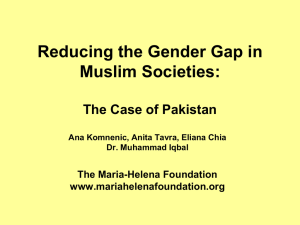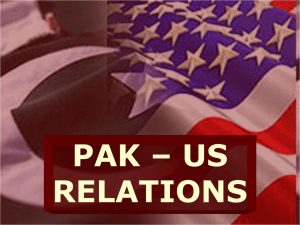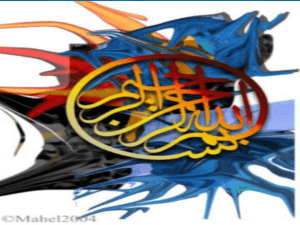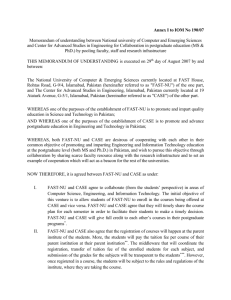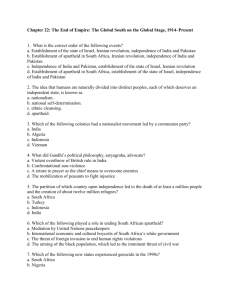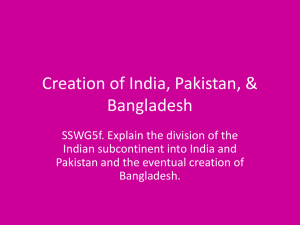EDUCATION-IN-PAKISTAN
advertisement
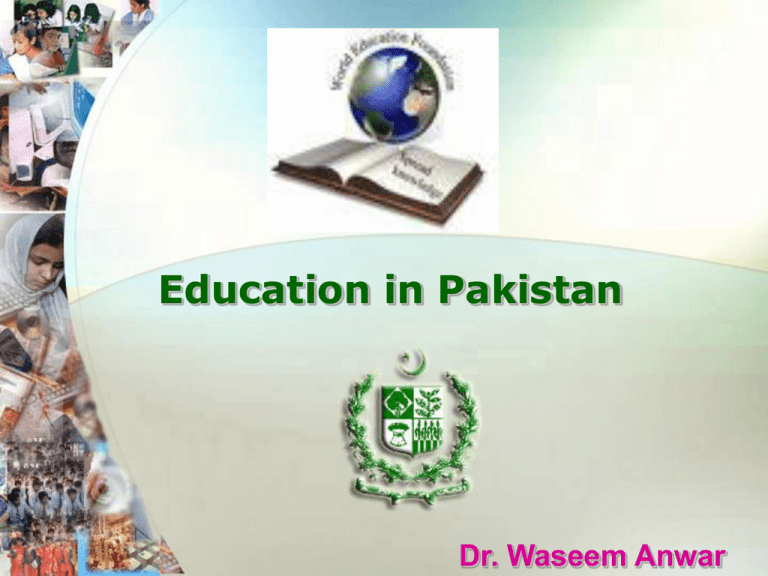
Education in Pakistan Dr. Waseem Anwar Contents PART - I • Definition of Education • Constitution of Pakistan PART – II 2 • Education Scenario • Education Policy Definition of Education The definition of education in common usage, that delivery of education is knowledge, merely the skills and information from teachers to students, is inadequate to capture what is really important about being and educated. 3 becoming The proper definition of education is the process of becoming an educated person. Being an educated person means you have access to optimal states of mind regardless of the situation you are in. 4 Constitution of Pakistan 5 Constitution of the Islamic Republic of Pakistan, 1973 – Article 37-b “The State shall remove illiteracy and provide free and compulsory secondary education within minimum possible period” 6 Concurrent Legislative List: Curriculum, syllabus, planning, policy, centers of excellence, standard of education & Islamic education 7 PART – II EDUCATION SCENARIO 8 Human Development Index Country Ranking (out of 177 countries) 2005 2006 2007 9 Iran 99 96 94 Sri Lanka 93 93 99 Maldives 96 98 100 India 127 126 128 Bhutan 134 135 133 Pakistan 135 134 136 Bangladesh 139 137 140 Nepal 138 142 136 Literacy Rates Literacy Definition (As in 1998 Census) “The ability of a person who can read a newspaper and write a simple letter in any language” 10 Literacy Rates • PAKISTAN = 55 % (Male = 67 %,Female = 42%) Province Literacy Rate 11 • Punjab= 60.2% • Sindh = 57.7% • NWFP = 49.9% • Balochistan = 48.8% Educational Institutions by Level Level Pre-primary Mosque school Primary Middle Secondary British System NFBE Total Public Private Vocational Deeni Madaris 1,081 14,123 122,349 38,449 25,090 281 4,831 1,882 116 1257 3,059 12,153 287 14,035 105,526 14,334 10,550 11 2,008 1,025 59 426 916 354 794 88 16,823 24,115 14,540 270 2,823 857 57 831 2,143 11,799 Others 3,120 2,241 879 Inter & Degree Colleges Universities Technical/ Professional 12 Institutions by Medium of Instruction 13 Type # of Institutions Urdu English Sindhi Total 227,791 14806 Public 151,744 103,186 3,035 33,384 Private 76,047 43,347 21,29 3,521 2277 3416 Others 22779 12,139 9,886 EDUCATION POLICY OF PAKISTAN 14 Challenges • Weakened Governance − Fragmentation − Lack of Clarity in Inter-Tier Relationships • Poor Quality of Teachers & Managers • Quality of curriculum, textbooks & exams • Low level of literacy • Out of school children • Dropouts 15 Challenges • • • • • Public Private Partnership In-adequate financing Gender Equity Poor monitoring & evaluation Imbalance in primary, middle & secondary schools • Inconvenient school location 16 SALIENT FEATURES OF NATIONAL EDUCATION PLAN • Universal and Free Primary and Secondary Education • Promotion of Equity • Minimum National Standards • Relevance to Labour Market • Sector Planning • Financial allocation of 7% of GDP by 2018 • Encourage Private sector • Link Allocations to Definition of Free Education • Improve Planning, Management and Implementation Capacity • Donor Harmonisation • Overcoming Fragmented Governance 17 SALIENT FEATURES OF NATIONAL EDUCATION PLAN • Bridging the Public Private Divide • Improved Examination System • Introduction of Early Childhood Education (3-5 years) & inclusive education. • Achieve the MDG goals. • All Primary schools shall be upgraded to Middle level • Well developed plan for expanding school facilities. • High priority to reducing drop out rates • Improved school environment • Career Counselling at higher secondary level • Develop national literacy curriculum • Enhance qualifications for employment as teachers 18 SALIENT FEATURES OF NATIONAL EDUCATION PLAN • Pre-service & in-service teacher training • Accreditation and certification of teachers • Merit based teacher recruitment, professional development, promotions & postings • Curriculum development • Competitive publishing of textbooks and learning materials • District Education Boards to be established for managing schools • Separate management & academic cadres 19 Allocation of Funds to Education: Year 2009-10 Non-Development (Rs. in million) Development Total 1. Ministry of Education 1,824.426 3,122.459 4,946.885 2. Higher Education Commission 7,045.608 9,104.436 16,150.044 3. Major Projects under Ministry of Education a. Madaris Reforms (Teaching of formal subjects in Madaris) b. Education Sector Reforms Program c. Establishment of 82,000 Community Schools in Pakistan 1449.000 800.00 170.510 AJK and FATA d. Science Education Project (Phase-II) ADB assisted FCU 84.670 e. National Education Assessment System (NEAS) 71.530 f. Establishment of Cadet College Zhob at Qilla Saifullah 50.000 20 Continue… (Rs. In million) 21 g. Establishment of Cadet College Panjgur 50.000 h. Upgradation of FG Secondary Educational Institutions to the level of Islamabad Model Colleges 45.000 i. Upgradation of FG Elementary Educational Institutions to the level of Islamabad Model Schools 40.000 j. Establishment of 350 Community Schools in hard to reach areas of FATA (NORAD assisted) 39.329 Future Plans for Education in Pakistan 1. Tripartite Partnership: The role of family, the community and the State. All need to be mobilized. 2. Free Education Upto Matriculation: 3. Provision of Free Textbooks: 4. Grant of Scholarships and Incentives to Girl Students: 5. Availability and Accessibility of Schools Particularly in Rural Areas. 22 Continue… 6. Teacher’s Status and Recruitment of Female Teachers: Better status and pay for teachers. Experience has demonstrated that schools with female teachers function well particularly at Primary level. 7. Improvement in Learning Environment: Better infrastructure through School Management Councils. 8. Technical / Vocational Education: It is important to provide demand related skills. 9. Instructional Methods: 23 Emphasis must be given on development of analytical faculties of the students. Continue… 10. Teachers’ Training and Knowledge: To improve teachers’ knowledge of the subject and equip them with a wide repertoire of teaching skills. 11. English Language: Introduction of English from Class – I. Future policy reforms will emphasize the teaching of science subjects in English at public secondary schools. 24 Thank You All 25

